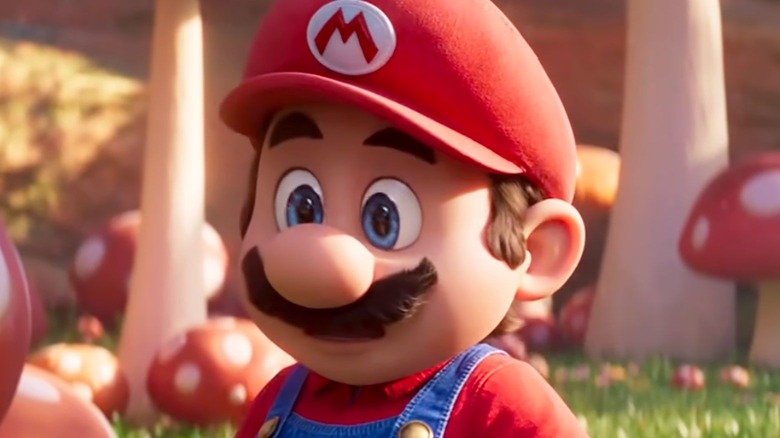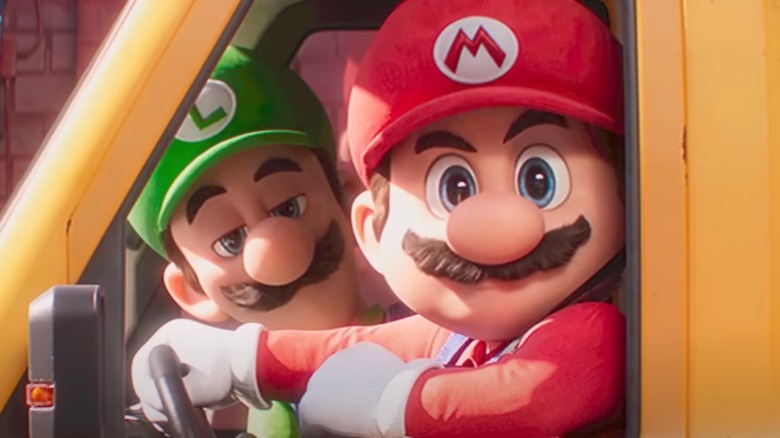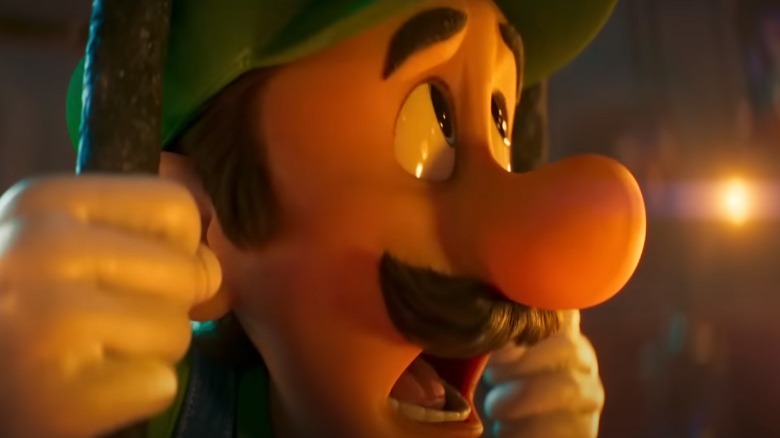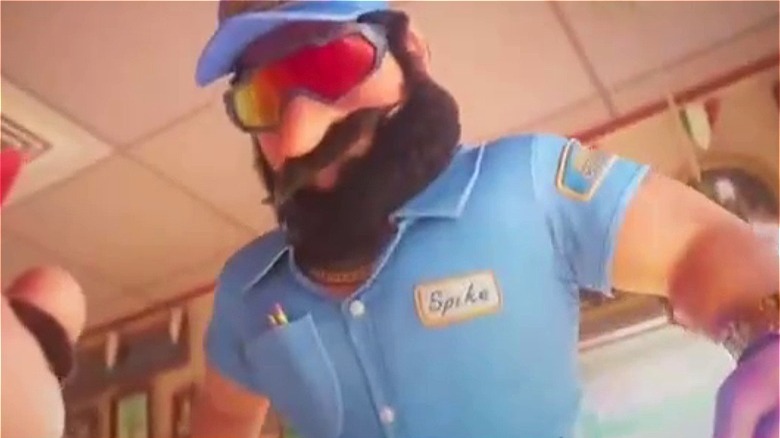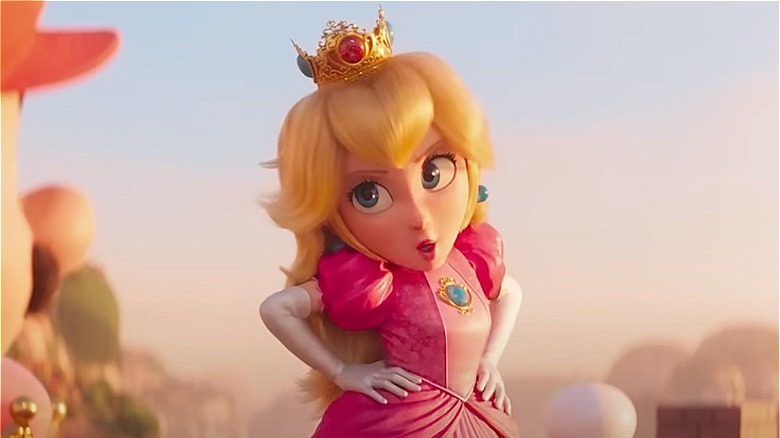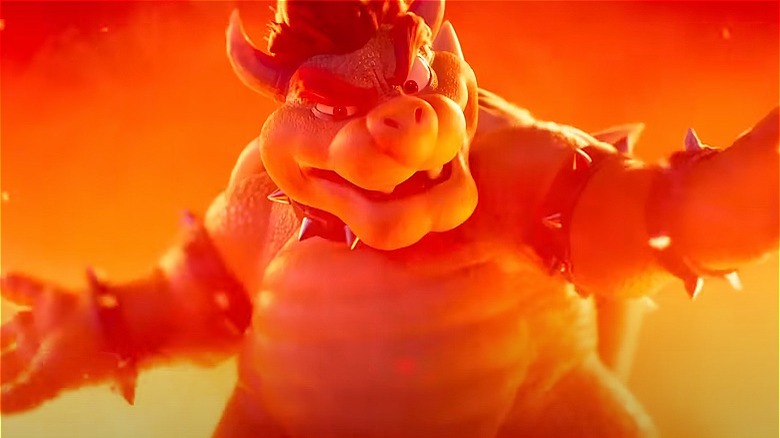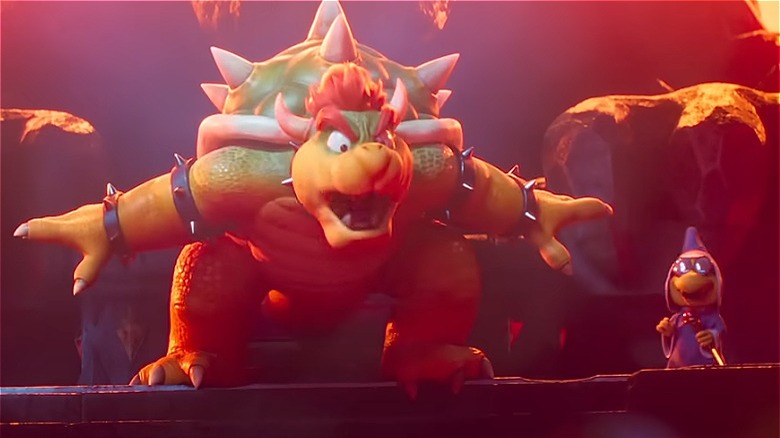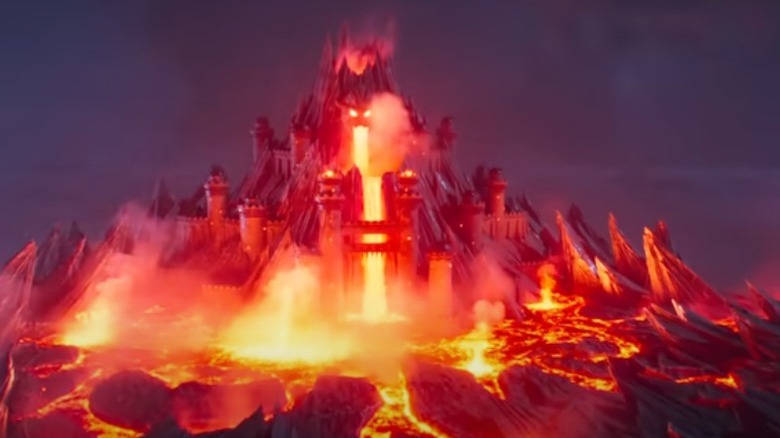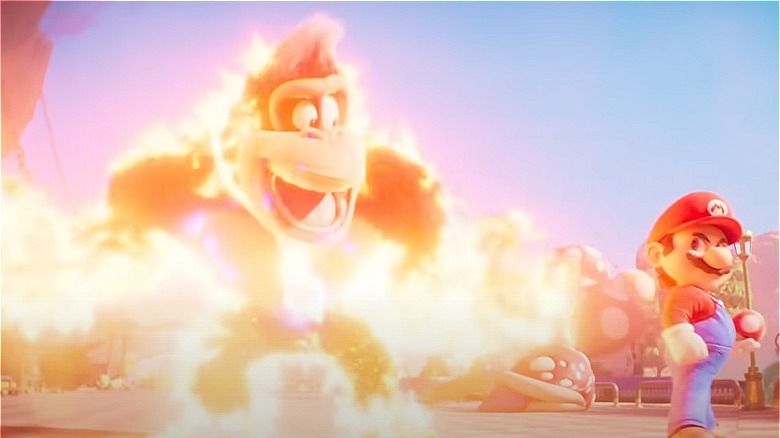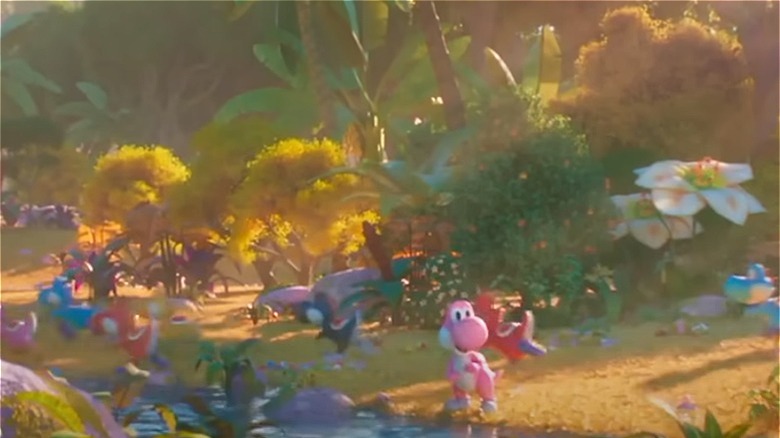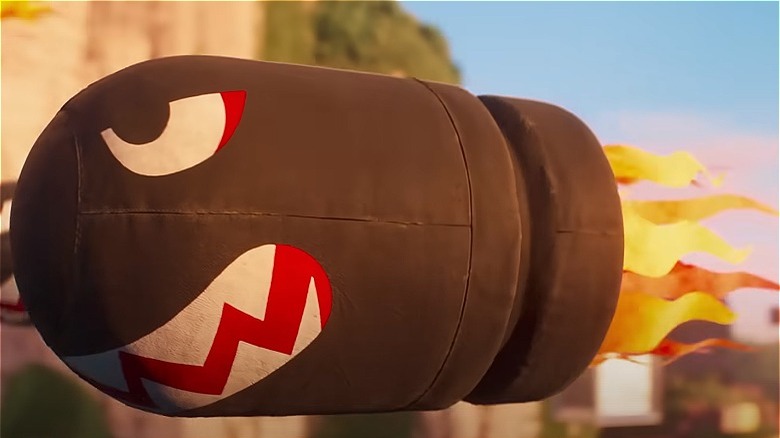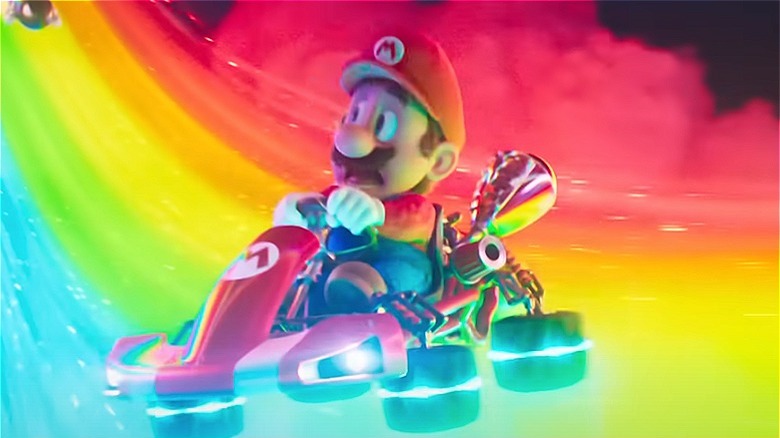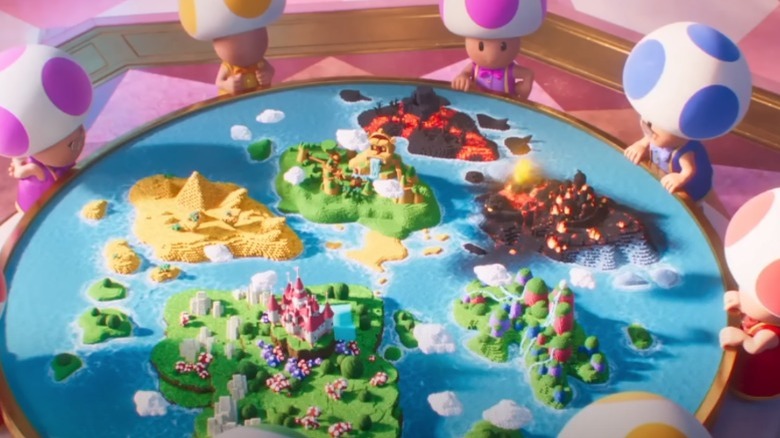The Biggest Differences Between The Super Mario Bros. Movie And The Games
As one of the most successful video game franchises of all time, "Super Mario" has also been adapted for both television and film several times over, but few of these adaptations have done justice to the "Mario" universe. Some "Mario" fans still aren't over the John Leguizamo-starring 1993 live-action "Super Mario Bros." — a darker story that reimagines the classic Mushroom Kingdom characters in human form.
Fortunately, the 2023 animated film "The Super Mario Bros. Movie" appears to have finally given fans a faithful adaptation — it's loaded with references to the "Mario" franchise and Nintendo classics alike. From familiar characters to game mechanics, fans are loving all of the details hidden in this latest adaptation. Plenty of scenes in the movie even faithfully recreate moments from the games down to their finer details. If you love a good power-up as much as we do, let's take a trip into the Mushroom Kingdom and ponder some of the biggest differences between "The Super Mario Bros. Movie" and the extensive canon of "Mario" games.
Mario
Fortunately, Mario and Luigi are perfectly suited for sliding through the pipes of the Mushroom Kingdom thanks to their day jobs as plumbers. In "The Super Mario Bros. Movie," they've recently filmed a commercial for their plumbing company. In fact, you can check out their company at its real-world website. The film goes a little deeper than the games to establish the Mario brothers' backstory by showing audiences their Brooklyn home where they live with their hypercritical dad and other extended family members.
Although the film's Mario is a pretty fair likeness to his video game counterpart, Chris Pratt's voice acting drew a fair amount of criticism when clips first hit the Internet. In the film, Mario and Luigi are portrayed with Italian American Brooklyn accents rather than the Italian accents they're known for in the "Mario" games, and fans have lamented the absence of an enthusiastic, "It's a-me! Mario!" Their classic Italian accents do pop up in the plumbing commercial where they serve as a gimmick along with the brothers' white gloves. But as anyone who has seen much older "Mario" media knows, the Brooklyn accents are hardly new to the franchise, having been featured in both the 1993 film and "The Super Mario Bros. Super Show!" cartoon and live-action series from 1989.
Luigi
As Mario's taller brother, Luigi (played by Charlie Day) is an essential part of the "Super Mario Bros." franchise. One of the more contentious points within the "Mario" fandom has always been Luigi's reputation for being a coward. His brother Mario is the star of the franchise and tends to get more glory. And many fans argue that Luigi's reputation as a scaredy cat is hardly valid, pointing out that he is happy to step up when he needs to. Although it's true that Luigi physically shakes in fear when exploring the haunted houses of the "Luigi's Mansion" series, he sallies forth anyway like the professional plumber that he is.
Nonetheless, "The Super Mario Bros. Movie" leans into Luigi's 'fraidy cat rep by stripping him of any chance to be a hero in his own right until the very end of the film. Early in the movie, Luigi ends up in Bowser's Kingdom, where he briefly faces off with some pretty frightening foes before getting tossed into Bowser's hanging dungeon where he stays for most of the story. Fortunately, Luigi eventually finds vindication when he and Mario save Brooklyn together with the brotherly teamwork we love to see.
Spike
The character of Foreman Spike originally hails from the game "Wrecking Crew," where he spends his time menacing Mario and Luigi's efforts at the worksite where he serves as their foreman. Like many characters in the Nintendo universe, Spike shows up elsewhere in the Mario games — he's the basis for a costume in "Super Smash Bros." and appears once again in a "Wrecking Crew" microgame in the Nintendo 3DS game "WarioWare Gold." Spike typically appears as a big-nosed dude wearing glasses, a construction hat, and a brown and yellow attire. In the game "Wrecking Crew '98," it's established that he works for Bowser. Although Spike also shows up in the 1993 live action film as one of Koopa's minions, that version bears little resemblance to the Foreman Spike from the game world.
Spike also appears in the 2023 film as a Brooklyn business owner who resents his former employees Mario and Luigi for stepping out on their own. In the film, he is a larger gentleman dressed in a blue work uniform and cap, but he still sports a pretty sweet pair of shades. When the brothers run into Spike in the pizzeria, he berates them, telling Mario cruelly, "You're a joke, and you always will be." By the end of the film, however, Mario and Luigi's heroics win him over — he even cheers the brothers after their big boss fight with Bowser draws to a close.
Princess Peach
In many "Mario" games, Princess Peach functions more like a plot point than a character. Mario is motivated by the classic damsel-in-distress trope — his ultimate mission is to rescue Princess Peach from Bowser, who has kidnapped her and plans to force her into marriage. As Slate's Nadira Goffe observed, it's a trope that exists only in service of the male figures in the story, denying Peach any agency within her own tale. With her pink gown and stereotypical princess attire, she calls to mind another famed princess with an equally unsettling story via her more than passing resemblance to Disney's "Sleeping Beauty" princess Aurora.
Peach first appears as a playable character in "Super Mario Bros. 2," the first of several expansions of her role in the "Mario" story, but it isn't long before she's back to getting kidnapped again in games like "Super Mario World" and "Super Mario 64," among others. It's a trope that doesn't hold up in 2023 when women account for almost half of the gaming community, and fortunately, it's a trope that "The Super Mario Bros. Movie" sets out to resolve.
According to the film, Peach (voiced by Anya Taylor-Joy) appears in the Mushroom Kingdom as a baby, presumably after getting lost in a pipe. The Toads take her in, and eventually put her in charge of their kingdom as their highly competent leader. Peach's role as kidnap victim is swapped with Luigi, and it's Peach who actually trains Mario to fight Bowser.
Bowser
Although the Jack Black-voiced Bowser looks a lot like his video game counterparts, the notorious autocratic lizard-monster's personality stands out as one of the 2023 film's more notable innovations. He still sports the same spiky shell, studded leather bands, and rockstar hair, but his scales and coloring undergo a well-deserved extra level of attention. As the primary antagonist of the "Mario" canon, Bowser rules over the Koopa Troop like a crime boss as they serve him in his continued efforts to kidnap and forcibly marry Princess Peach. Like Mario and Luigi, Bowser appears in dozens of Nintendo games, even showing up in the "Skylanders" series as a playable character.
Although he's traditionally portrayed as something of a hulking lug in the games, Jack Black's Bowser has been praised as one of the best performances in the film. This Bowser comes across as a stereotypical toxic "nice guy" with an entirely unhealthy obsession with Princess Peach. Bowser is also a fairly talented musician who spends his time performing for his minions when he's not taking over new territory or caging his victims in a dungeon. He's a very competent pianist despite having only three fingers and a thumb on each hand, as is evident from his hit rock ballad "Peaches."
Mario's motivation
The decision to switch out Peach for Luigi as Bowser's kidnapping victim has consequences for their characters. But it also dramatically changes Mario's motivation for defeating Bowser, creating a story that's more about the brothers than going after a princess whose entire job is to sit around waiting to be rescued. Luigi and Mario's bond as brothers is established early in their film through their commitment to succeeding as plumbers together. But the importance of that relationship to both of them becomes even clearer as they're sucked through the pipe vortex. Despite everything that's going on around them, Luigi reminds his brother that as long as they stay together, everything will be okay. So, the moment that they're separated, all they can think about is getting back to each other.
Whereas a damsel-in-distress story might have relegated Luigi to an afterthought, when the brothers decide to share the Super Star, uniting side by side against Bowser and his minions in their final boss battle, it's a moment that feels completely earned. It also makes just a little more sense given that the story is based on "Super Mario Bros." not a game called "Mario and Peach."
Bowser's castle
From Skeletor's Snake Mountain to Sauron's Barad-dûr, every super sketchy villain needs an ominous fortress to support their branding. And Bowser's Castle is about as ominous as they come. Although the freaky locale shows up often in "Mario" canon, it often looks pretty different from one game to the next. Sometimes it's floating in the sky like in "Super Mario Bros.: The Lost Levels," while other times it appears to be completely grounded as it is in "Super Mario All-Stars," indicating that it has the ability to move around from one point to the next. Although its color can vary slightly, Bowser's home turf is usually grayish with green-topped towers, reflecting the colors of its lord and master.
Bowser's castle flies in pretty early in "The Super Mario Bros. Movie" while Bowser takes over the Snow Kingdom. The movie's version of the castle resembles the iteration that shows up in "Paper Mario" which is built directly under Peach's castle and is used to take off with the whole darn thing. The castle is given a lot more detail from its spiky stalactites to the glowing fire that burns inside of it. Like Bowser himself, the castle definitely has a metal vibe to it, and it's one of the coolest ways the film reimagines the original gaming universe.
The power-ups
Throughout the "Super Mario" universe, Mario and his pals are aided by handy little tools called power-ups. These clever items temporarily endow their user with a special ability that helps them through the level ahead, and there are literally dozens of different power-ups found in all of the many Mario games. "The Super Mario Bros. Movie" does a good job of showcasing some of the most iconic power-ups, including the mushrooms that cause the person ingesting them to become either very large or very small. A few other power-ups that show up in the film with a fairly faithful likeness to their in-game versions include the bell that turns Mario into a cat, the fire flower, and the Tanooki Suit which Mario uses to fly by spinning his tail around like a whirligig.
One notable difference in the 2023 film is the coveted Super Star, an invincibility-granting star seemingly so powerful that it could turn Bowser's dreams of enslaving all of Mushroom Kingdom with Princess Peach at his side into reality. In the film, there seems to be only one Super Star, and it's presented as almost the holy grail of the "Mario" universe. In the games, these stars also grant temporary invincibility, but they're generally considered just another power-up.
Notable absences
"The Super Mario Bros. Movie" does a good job overall of including some of the most recognizable characters in the "Mario" universe, and that's no small feat. Shortly after Luigi ends up in Bowser's Kingdom, he finds himself tangling with a whole herd of Dry Bones — the cool-looking skeletonized Koopa Troopas with a frustrating ability to revive themselves moments after a successful attack. He also crosses paths with the Boos, the adorably menacing balloon-shaped ghosts that first appear in "Super Mario Bros. 3." The film is also populated with a host of creatures from Toads to penguins to Koopas and Kamek — so many that it's almost easy to overlook who didn't make it in the story.
One of the most notably absent creatures is Yoshi, although we get to see a herd of colorful Yoshis in one scene and the post-credits scene teases a cinematic Yoshi in our future. Princess Daisy, the tomboyish monarch of Sarasaland, is also nowhere to be seen. Other iconic "Mario" characters missing from the film include the cutesy Toadette and the Mario brothers' archnemeses Waluigi and Wario. Since we've yet to meet any of these individuals, there's always a chance they could make an appearance in the inevitable sequel given the success of the first film.
The Bills
In the "Super Mario" canon, Bullet Bills are slick-looking bullet creatures with intense faces. After they're shot out of Bill Blasters, Mario generally has to either avoid them or jump on top of them. Other Bills found in the "Mario" games include the bright red Bull's Eye Bills — the heat-seeking versions that show up in games like "Super Mario 64" — and the Banzai, aka Bomber Bills – the biggest brother of the trio. Unlike the Bullet Bills and Bull's Eye Bills, which have tiny arms and pumped-up fists as they seek their targets, the much larger Bombers don't have time or energy for silly things like hands.
Although the Bullet Bills appear in most of the "Mario" games, their role is fairly limited in the 2023 movie as they're fired out of karts by the Koopa Troopas in their efforts to stop Mario and his army from reaching Bowser. Bull's Eye Bills don't show up at all despite appearing in "Super Mario Bros. 3" and several other "Mario" games. Ultimately, the Bomber Bills are the scene-stealers of the "Super Mario Bros. Movie." They're first seen as a mock-up in Peach's obstacle course, and it's a good thing she includes them in Mario's training. As Mario and his pals face off with Bowser and company in the movie's climactic battle scene, Bowser gives the order to "Launch the Bomber Bill and destroy the Mushroom Kingdom!"
The karts
One of the most beloved game series in the "Mario" universe is the "Mario Kart" series, a multiplayer go-kart game that lets players race different Nintendo characters against each other. And luckily for fans of the racing series, the karts play a pretty key role in the film. Mario and Peach first get their karts in the Jungle Kingdom after convincing the Kong family to support their attack on Bowser. After Mario and Peach design their rides, they take off together with their army of kart-riding compatriots, ultimately ending up battling Bowser's army in a death-defying kart race on the Rainbow Road — one of the most memorable courses in the "Mario Kart" series.
Peach has one of the coolest rides in the film — a sleek modern pink motorcycle. Motorcycles are a racing option that rolled out with "Mario Kart" for Wii, showing up again in "Mario Kart 8" for the Wii U and "Mario Kart 8 Deluxe" for the Nintendo Switch, and Peach looks awfully slick in her white racing suit. For fans of the popular game series, it's fun to see some added context to the racing story and getting to see everyone's favorite "Mario" characters face off in the extended Rainbow Road battle makes for one of the most rewarding sequences in the movie.
The world map
The world map is an essential part of some games from the original "Super Mario Bros." series as it gives players a chance to view the entire world ahead of them and monitor their progress. In the context of the "Mario" games, these maps represent all of the levels Mario has to go through until he finally rescues Princess Peach. Most of Mario and Luigi's adventures take place inside the Mushroom Kingdom, which has its own share of various worlds inside of its borders. Although some of the worlds look familiar from one game to the next, players can expect to travel through a whole series of strange backdrops, often with new villains and power-ups uniquely native to that particular land.
The film is primarily set in the mushroomed landscape of Toad Town surrounding Peach's castle and spends little time exploring other vistas. Although Luigi explores some of the darker settings while he's stuck in Bowser's Kingdom, it would be nice to see the brothers set out on an epic journey through some more interesting terrains or even warp over to Donut Plains, Chocolate Island, or Yoshi's Island — a strong possibility for the down the road, since we know Yoshi will likely make an appearance in the next film.
